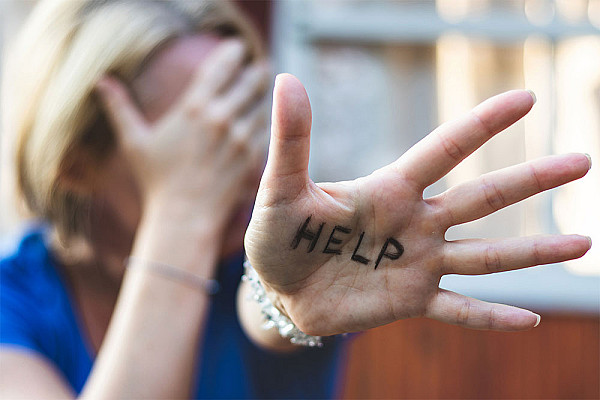Professionals
As professionals, we are in a unique position to recognise the signs of domestic abuse and offer essential support to individuals who may not know where to turn.
Domestic abuse affects one in four women and one in six men during their lifetime, and it transcends all areas of society. This means that, as a professional, you are very likely to encounter victims of domestic abuse.
Signs of Domestic Abuse to Look Out For:
 Victims of domestic abuse and their abusers often go to great lengths to conceal evidence of abuse, making the signs subtle and sometimes difficult to detect. While bruising and abrasions are the most common physical indicators, abuse is not always visible. Victims may become skilled at hiding the signs due to fear and shame.
Victims of domestic abuse and their abusers often go to great lengths to conceal evidence of abuse, making the signs subtle and sometimes difficult to detect. While bruising and abrasions are the most common physical indicators, abuse is not always visible. Victims may become skilled at hiding the signs due to fear and shame.
While every situation is unique, here are some common indicators that may suggest someone is experiencing domestic abuse:
- Unexplained Injuries: Bruises, cuts, or fractures that don’t match the explanation given.
- Frequent Medical Visits: Regular medical attention sought for injuries or stress-related symptoms.
- Untreated Injuries: Injuries that are hidden or left untreated, often due to fear of seeking help.
- Anxiety or Fearfulness: Appearing nervous, particularly around their partner, or displaying signs of fear. Worrying about not answering their phone or getting home in time for when their partner expects.
- A victim may avoid making eye contact with their abuser but still look to them for non-verbal cues. They may also be easily startled by sudden noises, such as a door opening or closing.
- Withdrawal: A noticeable loss of interest in activities, along with social isolation.
- Excessive Apologising: Constant apologising for things outside of their control.
- Hypervigilance: A state of being on edge, or overly alert, particularly in the presence of their partner.
- Low Self-Esteem: Expressions of worthlessness or self-blame.
- Minimising Abuse Behaviour: Downplaying or denying the severity of the situation due to fear or shame.
- Abusers themselves may display non-verbal signs, such as clenched fists or the victim may become silent after a look from the abuser. Often, the abuser will try to interrupt or talk over the victim when they speak, exerting control over the situation.
- Isolation: Restricted contact with family or friends, due to controlling behaviour.
- Monitoring: Concerns about being tracked or controlled, such as surveillance on their phone.
- Coercion: Being forced to comply with demands, such as restrictions on what they wear or where they go.
It’s crucial to remember that abuse can occur in relationships of any gender, and both men and women can be perpetrators or victims. Therefore, it’s important to approach all individuals, including friends or family members of the victim, with a critical eye.
If your ‘gut feeling’ tells you that something is not quite right, don’t ignore it. It might be nothing, but your help could mean everything to that person suffering abuse.
What to Do
 As a professional, you might be the first or one of only a few people the survivor has spoken to about the abuse. One of the most important things you can do is to ensure they feel believed, validated, and not judged. A supportive approach can make all the difference in helping someone find the courage to take the next steps towards safety.
As a professional, you might be the first or one of only a few people the survivor has spoken to about the abuse. One of the most important things you can do is to ensure they feel believed, validated, and not judged. A supportive approach can make all the difference in helping someone find the courage to take the next steps towards safety.
If you are concerned that they may be experiencing domestic abuse, offer to talk privately with them somewhere that they feel safe. Ask sensitive questions that help the person talk about their experiences. Listen carefully and avoid making assumptions. Exercise "professional curiosity."
If the person needs support to communicate, including an interpreter, use a professional who is impartial and has a duty to maintain confidentiality. Do not use family and friends.
Some Important things to get across, particularly following an initial disclosure:
- Let them know that you believe them
- Let them know that you want to help
- Reassure them that the abuse is not their fault
- Thank them for their bravery – it takes a lot of courage to open up about something like this
- Let them know that there is help available, they don't have to suffer alone– make sure they know where to find the contact details of relevant support services and who can help them.
- Offer to make a referral. Sometimes, a helping hand can make all the difference.
- Support with safety planning to increase their safety. You can refer to our safety planning guidance here
Assess and safety plan
Check the victim's safety, including whether the abuser is present, the whereabouts of any children, immediate concerns, and whether the victim has a safe place to go.
Consider if there is an immediate risk and seek management support and call the police if there is.
Check if the victim needs any medical attention and support them to access help and support if needed.
Discuss safety planning with the victim and help them to formulate a safety plan. Click here for safety planning guidelines
Explore options – Click here for information about Victim rights and options and help and support available for survivors
Make a Professional Referral to EDAN Lincs Refuge
If the victim needs access to refuge accommodation, contact EDAN Lincs Refuge at 01522 510041, or if outside of these hours, contact the National Domestic Abuse helpline at 0808 2000 247.
You can complete our Refuge Referral form by clicking here. However, before completing the form we suggest you call the refuge first to have an initial discussion about your client's needs.
Make A Professional Referral to our Outreach Service (LDASS)
 Click here to make a professional referral to our Lincolnshire Domestic Abuse Specialist Service
Click here to make a professional referral to our Lincolnshire Domestic Abuse Specialist Service
Top 10 Tips for Making a Referral:
- Obtain explicit consent from the victim before making the referral.
- Conduct the DASH risk assessment in a private environment without the perpetrator present. For guidance relating to the DASH and MARAC, refer to the LDAP Professionals Hub here.
- Inform the victim about the information recorded on the referral form and DASH, as this will be shared with them. If there is specific information that should not be shared, indicate it on the referral form.
- Do not use family or friends as interpreters.
- Be mindful of the presence of children over the age of two who may report back to the perpetrator. Avoid sensitive discussions in front of them.
- Be aware that the perpetrator may be listening to the conversation if the victim is holding a mobile phone during the meeting.
- Discuss safety planning with the victim and refer to safety planning guidelines. Call 999 in case of emergency.
- If children or adults are at risk, refer to your organisation's procedures for children and adults at risk and make a referral to Children's or Adult Services.
- Determine what your agency can do to help the victim be safe and which other agencies to contact.
- Ask if the victim wants further support or information to take away and ensure they have a safe place to keep it. Inform the client about the option to cover their internet tracks when accessing domestic abuse websites. See our technology safety tips here
Professionals Consultation Service
If you need any assistance or have specific questions about your role in supporting survivors of domestic abuse, please don’t hesitate to reach out.
Our professional consultation service provides one-off advice and support for those working with victims of domestic abuse in Lincolnshire. To request a consultation with one of our specialist domestic abuse practitioners, please contact the service by calling 01522 510041 and selecting option 2 when prompted. We are available between 9 am and 5 pm, Monday to Friday.
Anonymous Consultations
We understand the sensitivity of these situations. That’s why we offer the option of anonymous consultations. You can discuss the situation without revealing the identity of the person involved, ensuring their privacy and safety while still receiving expert advice.
Lincolnshire County Council Professionals Hub for Domestic Abuse in Lincolnshire
This is an excellent resource that provides a range of tools and information to assist professionals working with clients affected by domestic abuse, as well as resources related to the Lincolnshire MARAC (Multi Agency Risk Assessment Conferences) and the Domestic Abuse Related Death Review (DARDR), formerly known as Domestic Homicide Reviews (DHR).
The hub also offers a variety of resources to support professionals in Lincolnshire in helping those who are experiencing abuse or choosing to abuse a loved one, whether it be a partner, ex-partner, or family member.
Resources available on the website include the DASH risk assessment and guidance, MARAC information, referral forms, joint protocols, and process maps. Also where to go for support, training and a range of helpful videos produced by the Lincolnshire Domestic Abuse Partnership.
Click here to access the LDAP professionals' hub for domestic abuse in Lincolnshire
